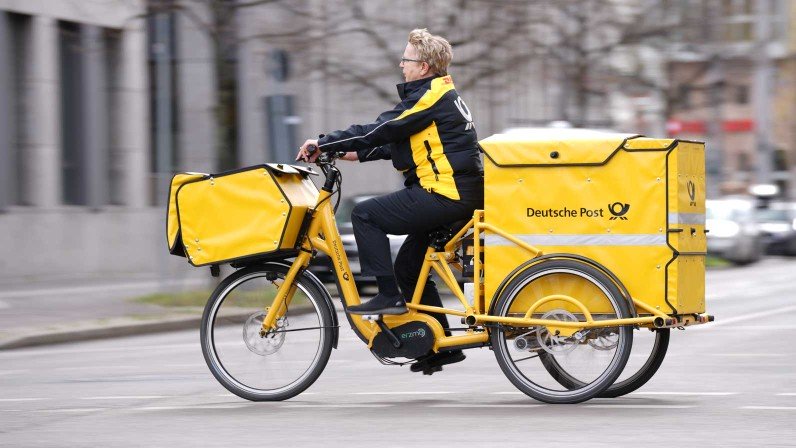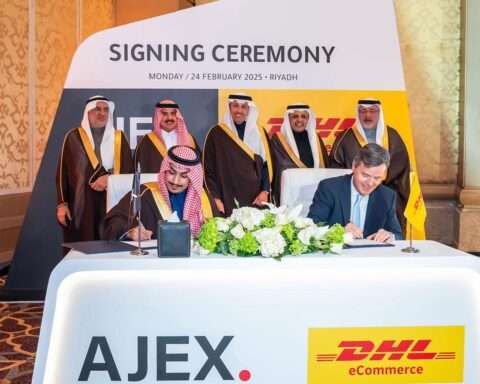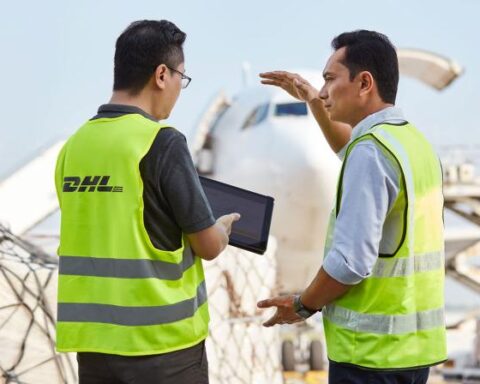Bonn – Four weeks ago, Deutsche Post DHL Group presented its new Sustainability Strategy, underpinning its 2050 zero emissions goal. In a further step, the Group has now specified how its Post & Parcel Germany division aims to become more climate friendly in the course of the coming years. Investments will be made in the construction of carbon-neutral production facilities, retrofitting existing buildings and further expanding the existing electric fleet.
The company also wants to initially triple the current 2% share of parcel shipments transported between larger parcel centers by rail, and in the longer term gradually increase that share to as much as 20%. Deutsche Post and DHL also plan to make their products and services “greener”: Alongside the current GoGreen portfolio, from 2022 further products and services will be offered which private and business customers can use to offset or even avoid emissions arising from parcel shipping. Also from 2022, the remaining carbon emissions generated in shipping national and international letter mail will be automatically offset via certified projects and at no extra charge.
Interview with Tobias Meyer, Board Member for Post & Parcel Germany
As Tobias Meyer, Board Member for Post & Parcel Germany at Deutsche Post DHL Group, explains: “Climate change is the most pressing challenge of our times. As Deutsche Post and DHL, we want to continue moving forward and expand our position in Germany as sustainability leaders in logistics. Despite the growing share of goods-related and transport-intensive shipments in our network, we will reduce the carbon emissions we cause, both directly and indirectly, and offset the remaining emissions to an even greater extent than before. We will transform our infrastructure and our processes, and offer new, climate-friendly products. Our goal is to remain the leading postal and parcel service provider – not least where environmental and social sustainability are concerned.”
Green buildings
By 2025 Deutsche Post DHL plans to build up to 280 carbon-neutral delivery bases throughout Germany. From those delivery bases, delivery staff paid according to Deutsche Post’s own company collective agreement will distribute mail and parcels to households in their various delivery districts. The new company-built delivery bases will feature photovoltaic systems, heat pumps in conjunction with underfloor heating and building automation. At some sites, battery storage systems will supplement the energy efficiency model. Solar power captured during the day is stored in the batteries and then used to charge e-vehicles overnight. To store the solar power, batteries taken from retired e-vehicles are used which – even after reaching their end-of-life in an electric vehicle – have sufficient storage capacity to allow their use as stationary chargers. This means they can be used as buffer storage to provide solar power for years to come. Compared with conventional buildings, each of the new delivery bases – relative only to the building itself – saves around 20 tonnes of carbon per year. With this measure alone, in 2025 the company will achieve carbon savings amounting to 5,600 tonnes.
Sustainability is also a top priority where upcoming large-scale buildings are concerned. The planned mail center in Germering near Munich, which is scheduled to go into operation at the end of 2023, will provide space for 1,300 employees and feature a 1.5 megawatt photovoltaic system, battery storage and a green roof and facade. Heating and cooling will be provided via a geothermal heat pump. And in Ludwigsfelde on the outskirts of Berlin, the new parcel center scheduled to open in 2022 will be supplied with electricity produced from solar panels. The building will also have its own combined heat and power plant which will provide electricity and heat. The overall share of green electricity at production facilities is to remain at a minimum of 95%.
E-mobility, charging infrastructure and e-trikes
Deutsche Post DHL is already an e-mobility pioneer – with over 15,000 StreetScooter branded electric vans, it is by far the largest e-fleet operator in Europe and beyond. In 2022, the fleet will grow to around 21,500 StreetScooters and a new model will be introduced: The first prototypes of the StreetScooter Gigabox with a load capacity of 12 cubic meters and space for some 240 parcels will be deployed in the course of this year. In 2025, the delivery fleet will then comprise 37,000 e-vehicles, including e-commercial vehicles from established vehicle manufacturers as and when available. Unlike combustion engines, electric vehicles are better suited to journeys involving the heavy stop-start city traffic usually encountered when delivering parcels and mail. Compared with a conventional van, an e-van reduces carbon emissions by around 4 tonnes per year. Thus, by 2025 Deutsche Post DHL will reduce its carbon emissions by an annual 150,000 tonnes.
The Group is also adapting is charging infrastructure to serve the needs of a growing e-fleet. As Germany’s largest private charging infrastructure operator, Deutsche Post DHL already has 20,000 charging stations at its production sites. By comparison: There are currently only 40,000 public and semi-public charging stations in Germany overall.
The Group’s e-fleet will be supplemented by 8,000 e-bikes as well as some 9,000 e-trikes – three-wheeled electric-powered cargo bikes. Deutsche Post plans to purchase a further 5,000 e-trikes by 2025. They provide an environmentally friendly means of transport for deliveries in city streets and with their high payload capacity, there’s enough room for small parcels to be carried too. Last year alone, 58 million small parcels were delivered using this carbon-neutral, environmentally-friendly transport mode.
Packstation network expansion
Packstations enable DHL customers to send and receive parcels easily and conveniently at any time of the day. This means they also play a role in climate protection: Compared to doorstep delivery, over the last mile a Packstation shipment reduces carbon emissions by an average 30%. At a Packstation, deliverers can deliver and also collect several dozen parcels per stop. Newer generation Packstations are also more energy efficient. Solar panels located above the parcel vending machines provide all the power they need. Given the environmental aspect and high customer demand, Deutsche Post DHL plans to expand the network to comprise more than 12,500 Packstations by 2023.
Shifting shipments to rail
To ensure provision of parcel transport and in the interest of shorter transit times, the company has a vast fleet of parcel network trucks out on the roads and highways each day. With the share of shipments sent by rail currently at just 2%, Deutsche Post DHL intends to triple that figure in the medium term. In the longer term, it is conceivable that around 20% of parcels could be transported by rail. For this to happen, a number of changes need to be made – from fast freight wagons to the availability of new locomotives, better rail tracks and fast, cost-effective loading options from truck to rail and rail to truck.
Since 2000, an Intercity parcel train has been speeding parcels across the country on a north-south rail line night after night. The share of rail transport has also been increased for less time-sensitive transports at weekends. And since the pre-Christmas peak season, in which twice as many trains were deployed as before, five weekend trains have been in operation for Deutsche Post DHL as part of a collaboration with rail freight company DB Cargo. To further expand climate-friendly parcel transport by rail, Deutsche Post DHL plans to equip selected larger parcel centers with rail sidings on site. The aim is to reduce transports to the terminals, speed up loading, and transport even greater volumes by rail in the available time windows.
Broader GoGreen product portfolio
Since 2007, Deutsche Post and DHL have been offering their GoGreen service as a way of offsetting – through certified climate protection projects – the carbon emissions unavoidably generated by shipping. For the past ten years, private customers’ parcels shipped within Germany have been automatically offset. From 2022, this will apply to all shipments of national and international letter mail items for both private and business customers. Customers incur no surcharge for this more sustainable shipping service.
Thanks in part to the substantial expansion of its e-fleet and by ensuring the design and construction of its own premises was climate friendly, DHL succeeded in decreasing its carbon emissions per parcel by 25% during the period from 2015/2016 to 2019/2020. Based on information from publically available sources and estimates derived from comparable logistics processes, the company believes that at present its carbon emissions per parcel are on average at least 30% lower than those generated by competitors on the parcel market. But even so, DHL intends to further expand its range of climate-friendly products by the end of 2020 as part of efforts to afford business customers greater transparency as to the quality of actual carbon savings made. In supplementing the GoGreen product range, the aim is to offer additional options and low-carbon parcel products from 2022, giving customers the opportunity to play an active part in reducing absolute carbon emissions.
Broader GoGreen product portfolio
Since 2007, Deutsche Post and DHL have been offering their GoGreen service as a way of offsetting – through certified climate protection projects – the carbon emissions unavoidably generated by shipping. For the past ten years, private customers’ parcels shipped within Germany have been automatically offset. From 2022, this will apply to all shipments of national and international letter mail items for both private and business customers. Customers incur no surcharge for this more sustainable shipping service.
Thanks in part to the substantial expansion of its e-fleet and by ensuring the design and construction of its own premises was climate friendly, DHL succeeded in decreasing its carbon emissions per parcel by 25% during the period from 2015/2016 to 2019/2020. Based on information from publically available sources and estimates derived from comparable logistics processes, the company believes that at present its carbon emissions per parcel are on average at least 30% lower than those generated by competitors on the parcel market. But even so, DHL intends to further expand its range of climate-friendly products by the end of 2020 as part of efforts to afford business customers greater transparency as to the quality of actual carbon savings made. In supplementing the GoGreen product range, the aim is to offer additional options and low-carbon parcel products from 2022, giving customers the opportunity to play an active part in reducing absolute carbon emissions.






